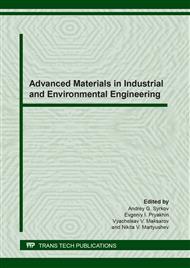[1]
L. A. Aleshina, N. V. Melekh, D. V. Loginov, Some Promising Materials of the North-West of the Russian Federation Based on Cellulose, Carbon and Silicates: Study Guide, Petrozavodsk State University, (2012).
Google Scholar
[2]
O. M. Ilyicheva, T. Z. Naumkina, N. I. Lygina, On the structural perfection of natural and synthetic silica, Herald of Kazan Technological University 8 (2010) 459-464.
Google Scholar
[3]
R. V. Sadovnichiy, A. A. Mikhaylina, N. N. Rozhkova, I. S. Inina, Morphological and structural shungite quartz features of Maksovskiy deposit, Proceedings of the Karelian research center of the RAS, Precambrian geology series, 2 (2016) 73-89.
DOI: 10.17076/geo126
Google Scholar
[4]
J. F. Bertone, J. Cizeron, R. K. Wahi, J. K. Bosworth, V. L. Colvin, Hydrothermal synthesis of quartz nanocrystals, Nano Letters 5 (2003) 655-659.
DOI: 10.1021/nl025854r
Google Scholar
[5]
K. Yu, Y. Guo, X. Ding, J. Zhao, Z. Wang, Synthesis of silica nanocubes by sol-gel method, Materials Letters 59 (2005) 4013-4015.
DOI: 10.1016/j.matlet.2005.07.055
Google Scholar
[6]
K. J. Murata, M. B. Norman II, An index of crystallinity for quartz, American Journal of Science 276 (1976) 1120-1130.
DOI: 10.2475/ajs.276.9.1120
Google Scholar
[7]
M. G. Krzhizhanovskaya, V. A. Firsova, R. S. Bubnova, Application of the Rietveld Method for Solving Powder Diffractometry Problems: Study Guide, Saint Petersburg State University, St. Petersburg, (2016).
Google Scholar
[8]
L.A. Aleshina, Crystal Radiography: Study Guide, Petrozavodsk State University, Petrozavodsk, (2004).
Google Scholar
[9]
S.S. Gorelik, Yu. A. Skakov, L. N. Rastorguev, Radiographic and Electrographic Analysis: Study Guide, Metallurgy, Moscow, (1994).
Google Scholar
[10]
L.M. Sochalski-Kolbus, Solvothermal synthesis and surface chemistry to control the size and morphology of nanoquartz, Crystal Growth & Design 15 (2015) 5327-5331.
DOI: 10.1021/acs.cgd.5b00882
Google Scholar
[11]
I.E. Kamentsev, The use of quartz as a reference for X-Ray studies and the accuracy of determining the parameters of its unit cell, X-ray analysis of mineral raw materials 7 (1970) 108-115.
Google Scholar
[12]
E.N. Svetova, I.S. Inina, X-Ray structural features of industrial varieties of quartz hydrothermal metamorphogenic veins of the Polar Urals, in: Materials of the VI Russian Seminar on Technological Mineralogy (2012) 102-105.
Google Scholar
[13]
S.K. Kuznetsov, V.P. Lyutoev, S. N. Shanina, E. N. Svetove, N. V. Sokerine, Features of quality of vein quartz of Ural deposits, News of the Komi Scientific Centre of the Ural Department of RAS 4(8) (2011) 65-72.
Google Scholar
[14]
N. N. Rozhkova, R. V. Sadovnichy, A. A. Mikhailina, I. S. Inina, Structural homogeneity of quartz of schungite rocks, Petrography of magmatic and metamorphic rocks: Materials of the XII All-Russian petrographic meeting (2015) 484-486.
Google Scholar
[15]
N.N. Rozhkova, S. S. Rozhkov, A. A. Kovalchuk, R. V. Sadovnichy, Nanoscale carbon and quartz of shungite rocks, Nanostructural material - 2016: BELARUS - RUSSIA – UKRAINE: Materials of the V International Scientific Conference (2016) 392-395.
Google Scholar
[16]
S.K. Kuznetsov, E.N. Svetova, S.N. Shanina, V.N. Filippov, Hydrothermal-metamorphic quartz veins impurity elements of the Nether-Polar Urals region, Geochemistry 9 (2012) 1-16.
DOI: 10.1134/s0016702912090054
Google Scholar
[17]
D.A. Lazarev, O.N. Kanygina, On determining the size of regions of coherent scattering of quartz crystals in clay systems, Herald of Orenburg State University 4(140) (2012) 221-225.
Google Scholar
[18]
H.P. Klug, L.E. Alexander, X-ray Diffraction Procedures for Poly Crystalline and Amorphous Materials, Wiley, New York, (1954).
Google Scholar
[19]
L.A. Danilevskaya, L. T. Rakov, Structural impurities in quartz as an important criterion for evaluating the quality of quartz raw materials and predicting its technological properties, Materials of the first Russian seminar on technological mineralogy (2006) 119-124.
Google Scholar
[20]
L.A. Danilevskaya, Quartz raw materials of Karelia region, Proceedings of Karelian Research Centre of RAS 6 (2006) 50-66.
Google Scholar
[21]
M. Fujiwara, K. Shiokawa, Y. Tanaka, Y. Nakahara, Preparation and formation mechanism of silica microcapsules (hollow sphere) by water/oil/water interfacial reaction, Chemistry of Materials 16 (2004) 5420-5426.
DOI: 10.1021/cm048804r
Google Scholar


